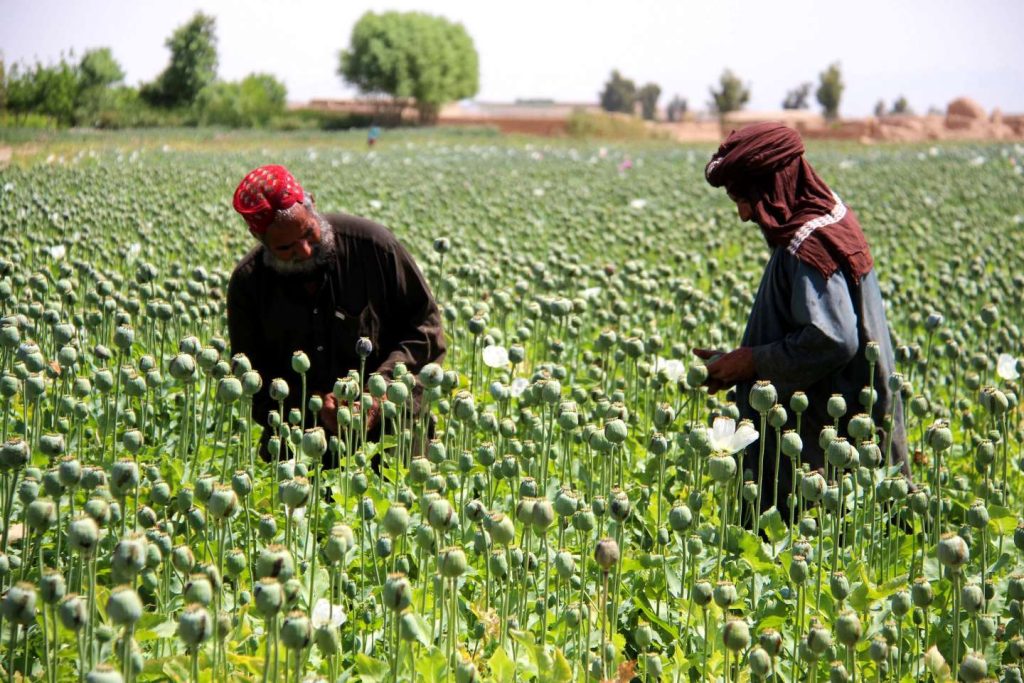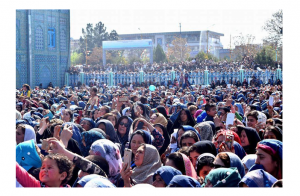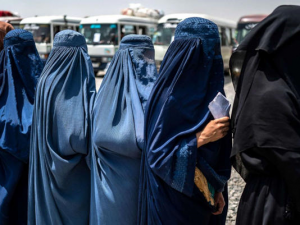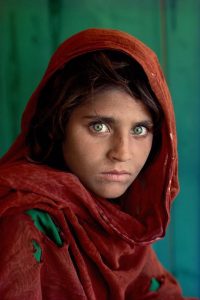A report published by the International Narcotics Control Board (INCB) on March 9, 2023, stated that the cultivation and production of opium in Afghanistan in 2022 was occurring on a large scale. It warned that despite the prohibition of opium cultivation by the Taliban leader, its production had increased by 32% compared to the previous year, due to the cultivation of opium poppy on 233 thousand hectares of land.
The United Nations Office on Drugs and Crime (UNODC) published a report in November 2022 which stated that opium cultivation had increased by more than 30% since the return of the Taliban, resulting in a tripling of earnings. This meant that farmers‘ income from the opium business had grown from 425 million dollars to 1.4 billion dollars, a threefold increase. According to the report, Afghanistan is responsible for 80 to 90 percent of the world‘s opium production and heroin, giving them almost a monopoly on global production.
In the Taliban leader‘s decree from last year, which prohibited the cultivation and production of opium, there was no mention of hashish, however, he has recently prohibited its cultivation.
Under the previous government, the cultivation and consumption of hashish had been declared illegal. Despite this, it was still widely cultivated, and now its production has increased. Currently, Afghanistan is the third largest producer of marijuana in the world, accounting for 10% of the world‘s production.
Taxes on the production and export of heroin and marijuana have always been a source of income for terrorists and a cause of instability. Therefore, in this article, we will briefly discuss the history of opium poppy cultivation in Afghanistan and its unfortunate consequences.
For many years, Afghanistan has been the leading country in the world‘s drug industry. According to the statistics of the UNODC, Afghanistan was identified as the largest producer of opium in 1992. Subsequently, in 1999, it achieved an unprecedented record with the production of 4,565 tons of opium globally. In 2000, opium production decreased, but since then, Afghanistan has been the primary source of opium production.
In 2007, opium production reached an unprecedented 8,200 tons, but later saw a slight decrease. Nevertheless, Afghanistan was responsible for more than 70% of the world‘s drugs. In 2014, 6,400 tons of opium were produced in the country, and although this figure decreased in 2015, Afghanistan remains the largest producer of opium, still accounting for 70% of the world‘s drugs.
Throughout its history, Afghanistan has not been a country that exports drugs. Instead, the production of opium poppy was limited and only used domestically. Most users consumed it as a sedative, as it was prescribed to patients with colds. The principle of prohibiting the trade, cultivation, purchase, sale, production, and use of opium was established in 1335 AH.
Prior to the 1980s, opium production in the country was 200 tons, a much lower figure than the 6,400 tons produced in 2014. During the Taliban regime in 1999, this number rose to 4,600 tons, and then to an unprecedented 8,200 tons in 2007. Since the start of the war, drug production in Afghanistan has increased significantly, due to turmoil, war, insecurity, regional and international gangs, drug trafficking, and poverty. This has resulted in Afghanistan becoming the largest producer of opium in the world, surpassing the Golden Triangle of Southeast Asia (Myanmar, Thailand, and Laos). Opium cultivation has also spread to Pakistan and Iran, with Afghanistan becoming the main source of production. The amount of opium produced in Afghanistan is now incomparable to that of Iran and Pakistan, with the latter producing the lowest amount and Iran being more renowned for drug smuggling and transit than for opium cultivation and production. The second largest producer of opium is Myanmar, with 840 tons produced in 2014.
It is estimated that the annual revenue from the heroin business in Afghanistan is approximately four billion dollars, a figure which is minuscule in comparison to its global market value of seventy billion dollars. Unfortunately, Afghan farmers, who are responsible for the cultivation and production of the drug, only receive one billion dollars, while the remaining three billion dollars are pocketed by smugglers and terrorists.
According to the report of the Food and Agriculture Organization of the United Nations, approximately 30% of farmers are engaged in opium poppy cultivation, although only about 7% of the country‘s irrigated land is dedicated to this sector. It is estimated that the average income of a farmer producing opium poppy is approximately 2,500 US dollars per year. Statistics from the Food and Agriculture Organization of the United Nations indicate that each Afghan farmer is responsible for the maintenance of 11 tons on average, meaning that approximately four million people make a living from opium poppy cultivation. The economic situation of these farmers is reported to be dire, as many of them are in debt to smugglers and terrorists who manage the chain of production and drug trafficking. These farmers are forced to borrow money to purchase agricultural tools and materials, as well as to sustain their livelihood.
The crucial question is how Afghanistan has become the primary source of opium poppy production. As previously mentioned, opium was brought to this land due to war, insecurity, and terrorism. The lack of a popular and responsible government and international measures to control drugs, terrorists, and smuggling networks have all contributed to this situation. The following are some of the factors of this situation:
- In the mid–1980s, insecurity and the loss of provinces to extremist groups led to a surge in drug production. Helmand, the largest province in Afghanistan, was the most insecure at the time, according to the United Nations Office on Drugs and Crime. Half of the opium produced in the country came from this province, where the government only had control of the city of Lashkargah, the center of Helmand. The rest of the province was under the control and influence of the Taliban. The three southern provinces of Helmand, Kandahar, and Farah produced around 4,700 tons of opium, which is approximately 75% of the total opium production in Afghanistan. When combined with Nangarhar, these four provinces produced 5,400 tons of opium, which is 85% of the total production. The remaining 15% was produced in other provinces.
- For regional terrorists and extremists, drug production and trafficking are seen as significant sources of revenue. Drug cultivation and terrorism are two destructive forces that are closely linked. Opium producers give 10% of their earnings to terrorists and extremists to protect them from official and unofficial interference in the industry, as they are responsible for the security of their fields, roads, and vehicles. The profits from the drug trade are a major factor in the proxy war waged by the neighboring country against the Afghan people.
- Given the aforementioned factors, the presence and business conditions are conducive to mafia gangs in the Afghan drug market both regionally and globally. These gangs transport drugs to regional and global markets, sometimes with the cooperation of the official authorities of the countries in the region, who receive monetary compensation in return. This illicit trade has, in some cases, impeded the fight against drugs.
- During the Republic, the cultivation, production, and trafficking of narcotics had become a lucrative source of income for corrupt professionals. The Islamic Republic of Afghanistan was not successful in combating drug production, despite the establishment of institutions such as the Counter Narcotics Justices Center (CNJC) and the Ministry of Counter Narcotics. The government‘s efforts in this regard were largely unsuccessful, and the market of drug cultivation and trafficking in the country became increasingly prosperous over time.
- During the Republic period, a significant amount of international aid was allocated to anti–narcotics programs, however, unfortunately, all efforts were unsuccessful.
Following the September 11, 2001 incident, the international community had a military and political presence in Afghanistan in order to effectively coordinate and manage the fight against terrorism and extremism. Consequently, different regions and areas of Afghanistan were divided into zones, with the control of each sector assigned based on the countries’ facilities. This included the international coalition. The United States took responsibility for the unstable parts of the east, while Canada was given control of the insecure regions of the south, such as Kandahar. Holland was assigned Uruzgan province, England was given Helmand province, Germany was entrusted with the northern areas, and Italy was given responsibility for the northwestern sections.
Likewise, the major defense and security tasks were divided between the coalition countries. The United States of America undertook the formation and training of the national army, Germany and the European Union were assigned the responsibilities of the national police, Italy was given the task of strengthening justice and judicial affairs, Japan was responsible for disarmament and collection of weapons, and England was mainly given the task of solving drug–related issues. Britain also sent a significant number of military forces to Afghanistan, hiring approximately 10,000 soldiers. From 2001 to July 2014, there were 404 casualties. Despite this extensive physical presence, planning of programs, and tolerance of losses, the security situation, drug cultivation, and trafficking increased over time. The number of drug users inside Afghanistan also increased, leading to addiction among many young people and families. In general, the Afghan government and its international allies failed to control drugs. Additionally, despite the propaganda of banning opium cultivation, the Taliban are taking advantage of the drug trade. Therefore, it appears that Afghanistan will not give up on drugs easily.
This article was originally published by Hasht-Sobh




